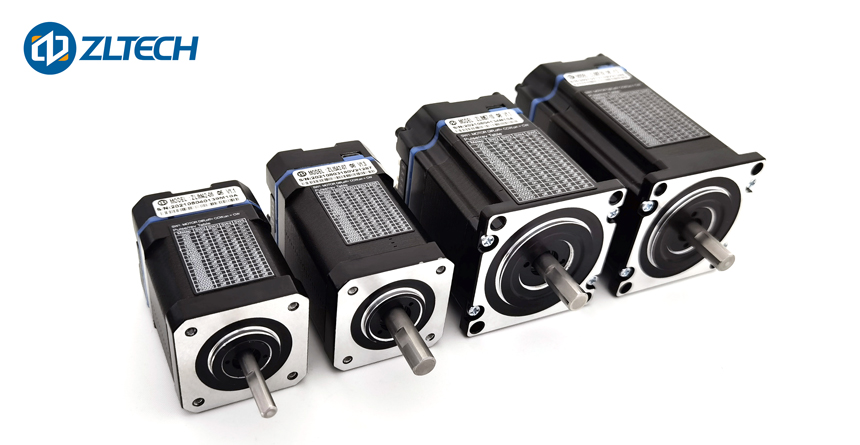Integrated stepper motor and driver, also referred to as "integrated step-servo motor", is a lightweight structure that integrates the functions of "stepper motor + stepper driver".
Structural composition of integrated step-servo motor:
The integrated step-servo system consists of stepper motor, feedback system (optional), drive amplifier, motion controller and other subsystems. If the user's host computer (PC, PLC, etc.) is compared to the company boss, motion controller is the executive, drive amplifier is the mechanic, and the stepper motor is the machine tool. The boss coordinates the cooperation among several executives through a certain communication method/protocol (telephone, telegram, email, etc.). The biggest advantage of stepper motors is that they are precise and powerful.
Advantages of integrated step-servo motor:
Small size, high cost performance, low failure rate, no need to match motor and drive controller, multiple control methods (pulse and CAN bus optional), easy to use, convenient system design and maintenance, and greatly reduce product development time.
Stepper motor selection:
Stepper motor converts electrical pulse signa to angular displacement or linear displacement. Within rated power range, motor only depends on frequency and number of pulses of the pulse signal, and is not affected by the load change. In addition, the stepper motor has the characteristics of small cumulative error, which makes It is easier to use stepper motor to operate control in the fields of speed and position. There are three kinds of stepper motors, and the hybrid stepper motor is mainly widely used at present.
Selection Notes:
1) Step angle: The angle the motor rotates when a step pulse is received. The actual step angle is related to the number of subdivisions of driver. Generally, the accuracy of stepper motor is 3-5% of the step angle, and it does not accumulate.
2) Number of phases: The number of coil groups inside the motor. The number of phases is different, and the step angle is different. If using subdivision driver, the 'number of phases' has no meaning. As step angle could be changed byu changing subdivision.
3) Holding torque: also known as the maximum static torque. It refers to the torque required by the external force to force the rotor to rotate when the speed is zero under the rated current. Holding torque is independent of drive voltage and drive power. The torque of a stepper motor at low speed is close to the holding torque. Since the output torque and power of the stepper motor change continuously with the increase of speed, the holding torque is one of the most important parameters to measure a stepper motor.
Although the holding torque is proportional to the number of ampere-turns of the electromagnetic excitation, it is related to the air gap between stator and rotor. However, it is not advisable to excessively reduce the air gap and increase the excitation ampere-turn to increase static torque, which will cause heat and mechanical noise of motor. Selection and determination of holding torque: The dynamic torque of stepper motor is difficult to determine at once, and static torque of motor is often determined first. The selection of static torque is based on the load of motor, and the load can be divided into two types: inertial load and frictional load.
A single inertial load and a single frictional load do not exist. Both loads should be considered during step-by-step (sudden) starting (generally from low speed), inertial load is mainly considered during acceleration (slope) starting, and frictional load is only considered during constant speed operation. In general, holding torque should be within 2-3 times of friction load. Once the holding torque is selected, the frame and length of motor can be determined.
4) Rated phase current: refers to the current of each phase (each coil) when motor achieves various rated factory parameters. Experiments have shown that higher and lower currents can cause some indicators to exceed the standard while others are not up to standard when motor is working.
The difference between integrated step-servo motor and ordinary stepper motor:
Integrated motion control system integrates motion control, encoder feedback, motor drive, local IO and stepper motors. Effectively improve the work efficiency of system integration and reduce the overall cost of the system.
Based on integrated design concept, reducers, encoders, brakes can also be added in application scenarios with other specific requirements. When drive controller satisfies self-programming, it can even perform off-line motion control without host computer, realizing real intelligent and automated industrial applications.

Shenzhen ZhongLing Technology Co., Ltd. (ZLTECH) has been focusing on the research and development, production and sales of industrial automation products since its establishment in 2013. It is a national high-tech enterprise with a number of product patents. ZLTECH product mainly includes robotics hub motor, servo driver, low-voltage DC servo motor, DC brushless motor and driver series, integrated step-servo motor, digital stepper motor and driver series, digital closed-loop motor and driver series, etc. ZLTECH is committed to providing customers with cost-effective products and high-quality services.
Post time: Nov-15-2022
